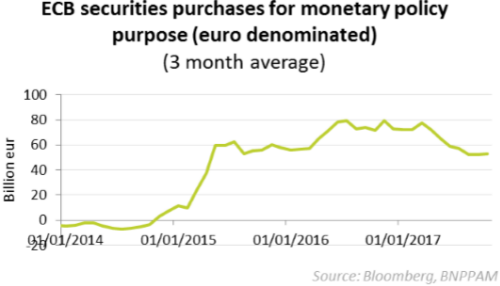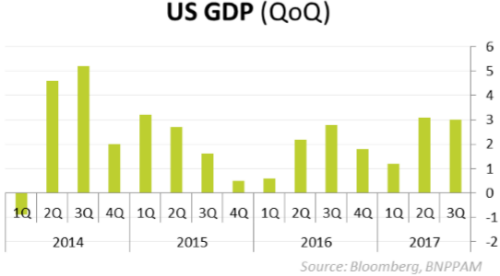
BNP Paribas AM: ECB prolongs quantitative easing programme
While Spain takes control after Catalonia declares independence the ECB prolongs the quantitative easing programme. In the US the low-volatility market environment was jolted by speculation over the next Fed chair and tax reforms. The weekly strategy update from BNP Paribas.
03.11.2017 | 08:47 Uhr
While we believe the Bank of England is getting ready to raise interest rates, ECB President Draghi announced the prolonging of its inflation and growth-boosting bond purchase programme until 2018, while halving the amount of monthly QE purchases from EUR 60 billion to EUR 30 billion. Market participants took this decision as a dovish move which supported European equities and caused the common currency to weaken. German Bunds rallied on the news. In the US, the low-volatility market environment was jolted by speculation over the next Fed chair, tax reforms moving closer to a deal in Congress and a busy week with company earnings reports. In all, this resulted in higher US Treasury yields amid improved economic indicators and a strong Q3 GDP growth number. Yet, the best-performing equity market was Japan which continued to enjoy Prime Minister Abe’s recent election victory and the likely continuation of BoJ president Kuroda’s loose monetary policy. Among currencies, the US dollar index rose further, up by almost 4% since its September low. Sterling gained on the back of stronger GDP figures.
In commodities, the energy complex was the best performer even as US crude oil inventories rose for the first time after four consecutive decreases, drawing support from news that Saudi Arabia favoured prolonging the existing OPEC production cuts beyond next March.
In emerging markets, the South African rand tumbled and government bonds sold off after Finance Minister Malusi Gigaba almost halved his GDP growth estimate for this year from 1.3% to 0.7% and forecast larger deficits over the next three years. With South African bonds representing about 10% of the JPMorgan GBI index, the news caused the EM debt benchmark to fall.
SPAIN TAKES CONTROL AFTER CATALONIA DECLARES INDEPENDENCE
The struggle between Spain and Catalonia escalated further as the Catalan parliament declared independence by voting for the formation of an ‘independent and sovereign state’ and Spain’s prime minister responded by securing Senate approval to overthrow Catalan President Puigdemont and bring the region under Spanish control. PM Rajoy has the backing of EU leaders who generally oppose states fragmenting and who will not easily recognise an independent Catalonia nor grant it EU membership. European Commission President Jean-Claude Juncker said: “There isn’t room in Europe for other fractures or other cracks. We’ve had enough of those... We are not in favour of letting Europe develop so that tomorrow we’d have 95 member states. Twenty-eight is enough for now”.
To avoid a policy mistake and prevent the situation from escalating further, Rajoy called for early regional elections on 21 December. This will be a key vote as it will be legally recognised by Spain even if the result turns out to be in favour of a pro-independence party. As highlighted in our previous weekly comment, we remain constructive on Spain, but our Macro Team reckons that a disorderly exit would be catastrophic for Catalonia. Meanwhile, many companies have already relocated in other Spanish regions, such as CaixaBank, whose CEO remains confident that the political leaders will resolve the situation soon.
ECB PROLONGS QUANTITATIVE EASING
 The ECB decided to prolong its bond purchase programme until September 2018, while reducing the monthly purchase amount to EUR 30 billion from this January. This had been well telegraphed to market participants. In fact, many investors had expected a bigger reduction to EUR 20-25 billion a month, especially after ECB Chief Economist Praet highlighted that the recovering economy could make do with a longer programme extension, thus hinting at a deeper cut in the purchases.
The ECB decided to prolong its bond purchase programme until September 2018, while reducing the monthly purchase amount to EUR 30 billion from this January. This had been well telegraphed to market participants. In fact, many investors had expected a bigger reduction to EUR 20-25 billion a month, especially after ECB Chief Economist Praet highlighted that the recovering economy could make do with a longer programme extension, thus hinting at a deeper cut in the purchases.
President Draghi stressed the economic expansion was solid and broad-based, but also noted that ‘domestic price pressures are still muted’. He repeated that interest rates would remain low well past the end of the programme, adding that QE would not stop abruptly next September and could even be further prolonged.
IMPROVING FUNDAMENTALS AWAIT THE NEXT US FED CHAIR US
President Trump is expected to nominate the next chair of the Fed in the coming days. According to US media leaks, the current chair, Janet Yellen, could be replaced by Jerome Powell, who already sits on the board of governors of the Fed. In an interview, President Trump said he would make up his mind in “the next very short period of time”, adding that “[the appointment] won’t be a big shock”. The reports pushed Treasury yields higher.
More importantly, news of progress on the tax reform plans supported risk assets. The House of Representatives passed the 2018 budget following Senate approval, marking an important step towards changing US tax law so that the federal deficit can be raised by up to USD 1.5 trillion over the next 10 years. The House is expected to present its version of the tax bill this Wednesday (1/11) and the Senate should follow suit next week. Our Macro Team now believes there is a two-thirds chance of tax cuts passing into law by the end of Q1 2018, up from an earlier 55% probability.
 Meanwhile, the US economy continues to strengthen. So far, the company earnings reporting season has provided mainly positive figures, with 80% of the companies reporting beating analysts’ earnings per share (EPS) forecasts and about 70% exceeding sales estimates, marking the highest percentages since Q2 2011. Information technology stocks in particular surged on the back of excellent sales growth in the sector, including news from Amazon of a 34% jump in sales. More generally, US GDP recorded solid growth in the third quarter, up by 3% QoQ. However, growth was helped by a strong rise in inventory investment. In terms of soft data, the flash estimate for the purchasing managers index for October surprised to the upside, with the composite PMI at 55.7, which is its highest since November 2015.
Meanwhile, the US economy continues to strengthen. So far, the company earnings reporting season has provided mainly positive figures, with 80% of the companies reporting beating analysts’ earnings per share (EPS) forecasts and about 70% exceeding sales estimates, marking the highest percentages since Q2 2011. Information technology stocks in particular surged on the back of excellent sales growth in the sector, including news from Amazon of a 34% jump in sales. More generally, US GDP recorded solid growth in the third quarter, up by 3% QoQ. However, growth was helped by a strong rise in inventory investment. In terms of soft data, the flash estimate for the purchasing managers index for October surprised to the upside, with the composite PMI at 55.7, which is its highest since November 2015.
ASSET ALLOCATION: TAKING PROFITS ON AUSTRALIAN BONDS VS. TREASURIES
We took profits on our relative long Australian government bonds versus US Treasuries trade. As a reminder, we had opened this position in anticipation of yield convergence. On the one hand, we had expected Australian yields to fall since most of the positive economic news had already been priced in. On the other, we assumed that the US market had discounted any bad news, with sluggish inflation and a dovish Fed leaving room for an upside surprise in yields. As yields converged, our target came into sight and we closed half of the position at a profit. We are underweight duration, particularly in European bonds, as we expect the ECB to be one of the first major central banks to place greater emphasis on prudent management of financial markets.
In currencies, we remain long USD versus EUR. Over the medium to long term, we see the USD strengthening, especially once the Trump administration starts implementing reforms and as the Fed proceeds with its monetary policy normalisation plan.
On real estate, European stocks have rallied significantly this year, while US real estate has lagged. This encourages us to maintain our overweight in US real estate as we expect this divergence to reverse over the coming months amid a pick-up in demand for US real estate.



Diesen Beitrag teilen: